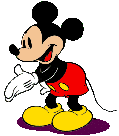
 2003
2003|
Frances Weller Bailey |
|
|
Office: New Snell 182 |
Phone: 268-3969 |
|
Office Hours: T & Th, 2:30-5:00 pm |
E-Mail Address: fbailey@clarkson.edu |
Patrick Drazen, Anime Explosion: The What? Why? & Wow! Of Japanese Animation (Stone Bridge Press)
Norman M. Klein, Seven Minutes: The Life and Death of the American Animated Cartoon (Verso Books)
Leonard Maltin. Of Mice and Magic: A History of American Animated Cartoons (revised ed.; Plume Books)
Richard Schickel, The Disney Version (third ed.; Ivan R. Dee, Inc.)
Carole A. Stabile and Mark Harrison, eds., Prime Time Animation: Television Animation and American Culture (Routledge)Kevin Peaty and Glenn Kirkpatrick, Flash Cartoon Animation: Learn from the Pros (friends of ED) [recommended for film team purchase]
The Adventures of Rocky and Bullwinkle (1958-1961; 38 min.; dir. Jay Ward and Bill Scott)
Akira (1988; 124 min.; dir. Katsuhiro Otomo)
Betty Boop in Boop-Oop-A-Doop (1985; 74 min.; dir: Vernon P. Becker)
Cartoons Go to War (1995; 58 min.; dir: Sharon K. Baker)
Chuck Jones: Extremes and Inbetweens, A Life in Animation (2000; 85 min.; dir. Margaret Selby)
Cowboy Bebop, Session 16: Black Dog Serenade (1998; 25 min.; dir. Shinichiro Watanabe)
Felix: A Star is Born (1919-1930; 21 min.; dir. Otto Messmer)
Gerald McBoing Boing (1950-1955; 29 min.; dir. Robert Cannon)
The Hand Behind the Mouse: The Ub Iwerks Story (1999; 90 min.; dir. Leslie Iwerks)
Mickey Mouse in Living Color (1928-1940; 56 min.; dir. Ub Iwerks, Walt Disney, et al.)
The Origins of American Animation (1900-1921; 83 min.; various directors)
The Simpsons: Trick or Treehouse (1989-1995; 60 min.; dir. Matt Groening)
Snow White and the Seven Dwarfs (1937; 87 min.; dir. Bill Cottrell)
Spirited Away (2002; 125 min.; dir. Hayao Miyazaki)
Who Framed Roger Rabbit? (1988; 103 min.; dir. Robert Zemeckis)
In this class, students study basic film technique, applying that knowledge to animated shorts and films made between 1906 and the present. Taking an historical perspective, the course traces the evolution of the art of animation from silent era experiments in animated shorts to computer animation and anime. Since animation is a form of film that is produced relatively quickly, it can respond more immediately to issues and ideas in the surrounding culture than can feature films; therefore, a primary focus in this course will be the interaction between developing technologies of animation and the society that both produces and consumes them.
To apply the knowledge gained from reading and viewing, students will work in teams to script, storyboard and produce a short animated film, using either Macromedia Flash or Adobe Premiere. Additionally, students will take an active role in class discussions by presenting brief lectures on aspects of animation that particularly interest them.